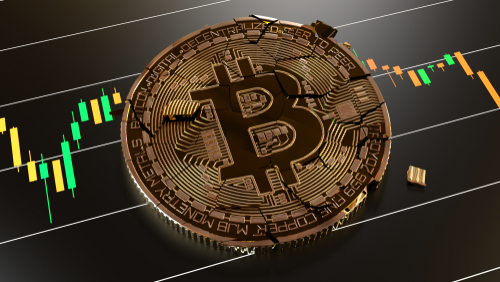

Crypto markets initially rallied this week after the ISM manufacturing purchasing managers index (PMI) fell to 50.9 in September (the lowest level since May 2020) against an expected 52.2. Bitcoin opened the week around $19,000 before hitting intraday highs of around $20,400 yesterday. It is currently trading at around $19,500 after the release of higher-than-expected NFP data for September (+263k).
This article is only available to Macro Hive subscribers. Sign-up to receive world-class macro analysis with a daily curated newsletter, podcast, original content from award-winning researchers, cross market strategy, equity insights, trade ideas, crypto flow frameworks, academic paper summaries, explanation and analysis of market-moving events, community investor chat room, and more.
Crypto markets initially rallied this week after the ISM manufacturing purchasing managers index (PMI) fell to 50.9 in September (the lowest level since May 2020) against an expected 52.2. Bitcoin opened the week around $19,000 before hitting intraday highs of around $20,400 yesterday. It is currently trading at around $19,500 after the release of higher-than-expected NFP data for September (+263k).
The downside surprise to the ISM PMI is an early sign that Federal Reserve (Fed) tightening is beginning to impact the economy and slow growth. This has contributed to the ‘Fed pivot’ narrative. The rationale is that the lower-than-expected ISM PMI increased the chance of the Fed pumping the breaks, which would be bullish for risk assets. However, Fed speakers remained hawkish last week; we still expect another 75bp hike in November. Lastly, caution should be exercised around the recent risk rally as equity markets are likely influenced by large month- and quarter-end flows. We continue to have a bearish bias on risk.
Today, non-farm payrolls (NFP) for September came in at +263k vs +255k estimated (we previously noted that any surprises could rile markets) and unemployment fell to 3.5%. This directly counters the ‘Fed pivot’ narrative and provides little hope that the Fed will dampen the pace of rate hikes. Crypto markets have reacted accordingly – bitcoin was trading at around $20,000 in the moments before the NFP release and has dropped to around $19,500 in the minutes after.
Performance of Our Indices
As for our various indices, our Bitcoin index (+2% WoW) is up the most (Charts 1 and 2). Our DeFi and Privacy indices are up around +1% each and our Metaverse index is flat. Lastly, our Smart Contract index is the only that is down (-2% WoW)
Our Metaverse (86%) and Privacy (75%) indices are correlated most to bitcoin, while our Smart Contract (48%) and DeFi (44%) indices are correlated least to bitcoin (Chart 3). On macro markets, bitcoin’s correlation to tech stocks drops again while its correlation to gold rises to 47% (Chart 4).
- Smart Contract Platform Index: Ethereum (ETH) is up the most (+1% WoW) and EOS (EOS) is down the most (-4% WoW).
- DeFi Index: Maker (MKR) is up the most (+14% WoW) and PancakeSwap (CAKE) is down the most (-6% WoW).
- Metaverse Index: Phantasma (SOUL) is up the most (+14% WoW) and Enjin Coin (ENJ) is down the most (-4% WoW).
- Privacy Index: Dusk Network (DUSK) is up the most (+11% WoW) and Zcash (ZEC) is down the most (-3% WoW).
- Bitcoin: this is up 2% WoW.

What Are in the Four Indices?
Here are the indices in more detail:
- Bitcoin: the OG of crypto markets deserves its own category and is in many ways the true benchmark for any other crypto market.
- Smart contract platforms: after bitcoin, the big innovation was to have blockchains that were more programmable. These could host smart contracts or decentralised applications and have allowed the emergence of the metaverse and defi. Ethereum (ETH) is the most popular version of a smart contract platform. As well as ethereum, we also include some key competitors. The constituents of this index are: Ethereum (ETH), Cardano (ADA), Avalanche (AVAX), Solana (SOL), Fantom (FTM), VeChain (VET), Terra (LUNA), EOS (EOS), and Chainlink (LINK). We also include Polkadot (DOT) which allows interoperability between blockchains and the use of smart contracts via parachains.
- Metaverse: coins associated with the creation of a virtual space/digital world on the internet using a combination of augmented reality, virtual reality, and social networks. The constituents of this index are Axie Infinity (AXS), The Sandbox (SAND), Decentraland (MANA), Enjin Coin (ENJ), Aavegotchi (GHST), Terra Virtua Kolect (TVK), Ultra (UOS), Phantasma (SOUL), RedFOX Labs (RFOX), and Gala (GALA).
- Decentralised Finance (DeFi): financial services built on top of blockchain networks with no central intermediaries. This can be a broad category, so we narrow this down to platforms that focus on lending/borrowing, yield farming, automated market making and decentralised exchange tokens. The constituents of this index are: Aave (AAVE), Compound (COMP), Uniswap (UNI), Yearn.finance (YFI), Loopring (LRC), PancakeSwap (CAKE), Maker (MKR), 1inch (1INCH), Thorchain (RUNE), and Terra (LUNA).
- Privacy Coins: coins that obscure transactions on the blockchain to maintain the anonymity of its users and their activity. The constituents of this index are Monero (XMR), Zcash (ZEC), Dash (DASH), Verge (XVG), Horizen (ZEN), Beam (BEAM), Secret (SCRT), Decred (DCR), Keep Network (KEEP), and Dusk Network (DUSK).
Dalvir Mandara is a Quantitative Researcher at Macro Hive. Dalvir has a BSc Mathematics and Computer Science and an MSc Mathematical Finance both from the University of Birmingham. His areas of interest are in the applications of machine learning, deep learning and alternative data for predictive modelling of financial markets.
Bilal Hafeez is the CEO and Editor of Macro Hive. He spent over twenty years doing research at big banks – JPMorgan, Deutsche Bank, and Nomura, where he had various “Global Head” roles and did FX, rates and cross-markets research.
